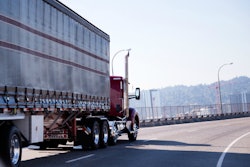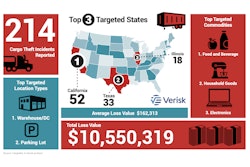
The Federal Motor Carrier Safety Administration released a proposal to slightly alter the guidance issued to carriers and drivers involving the use of their truck as a personal vehicle to drive to their home or to restaurants and motels along their route.

You can make comments online by Jan. 18.
The key change to the personal conveyance guidance is the removal of the requirement that trucks be unladen to be used for personal conveyance. FMCSA says the change is mostly meant to allow straight truck drivers the opportunity to use their truck, even if it is laden with work- or load-related materials or tools, for personal use.
Here’s a sampling from the federal government’s website of what some people have said about the proposed change and other topics.
Gary Holmes: So I have been in trucking for 18 years with no accidents or tickets. Today I started using electronic logs and I have to say I have never been so stressed out in my life. I found myself racing a stupid computer and running faster than usual. These things are dangerous. Now I see one of the reasons so many new drivers have accidents; they make you feel like you can’t even stop to use the bathroom. To whom it may concern, I believe there will be a lot more accidents because of these things I feel that I will have to get out of trucking and fold my business up. I do not feel safe and I do feel like they make me dangerous to be on the road.
Dan Roe: As a driver for more than 30 years I believe it is imperative that commercial drivers be able to use those vehicles for personal conveyance while off duty whether unladen or not to take short trips to places of rest and for any other personal business such as hygiene and nutrition. In other words, a commercial driver should be able to use a commercial vehicle while off duty for personal well being.
Gary Harrison: As a driver that is a 36 year veteran I feel the personal conveyance rule should stay. Actually I feel that easing up on that regulation could be a good thing because of the parking situation after the ELD mandate went into affect. The parking situation changed dramatically after Dec. 18. If the driver needs to go to the next nearest spot to park and have facilities this ruling is for this would be a huge benefit and ease up on the parking nightmare we face all the time. I know this original ruling is for going to a hotel, to a restaurant, etc. It is also beneficial for drivers who own their own equipment or are allowed by the carrier to use the truck for going home. Many companies do this because that is the drivers only transportation to and from work. Please understand the need we have for more flexibility due to the increase in trucks,traffic and the current HOS rules.
Kennon Nilsen: Personal conveyance as it relates to the owner/operator needs to have a broad and general application. As a truck may be the actual home for a driver then wide latitude must be given for personal usage. Laden or unladen, if the CMV is used for personal options that are out of route for commercial routing purposes then PC should be allowed. Reasons for use of PC.
- Attend religious activities
- Proceed to residence no matter the distance if not booked for another load in that exact direction.
- Movement for the purpose of acquiring food, medicine, medical treatment, and general supplies.
- Movement for the purpose of personal entertainment or non-work related activities
- Movement for the purpose of maintenance or repairs
- Movement from last delivery to nearest safe haven for parking purposes when no load is booked.
Dave Quigley: Drivers who are operating under a carrier with a “Satisfactory” safety rating should be permitted to operate in a personal conveyance mode regardless of “laden unladen”. The issue of parking and the ability to leave the trailer at a location is increasingly difficult. I am not aware of any safety issues that allowing the laden vehicle to be used as a personal conveyance versus an unladen bobtail. Any accommodations for those fleets operating in a satisfactory safety rating should be allowed to improve driver quality of life while on the road. The restrictions of distance and or time in determining a “personal conveyance” status are to restrictive and cannot account for all circumstances when a driver may use the vehicle for his personal needs. Consideration for private fleets, (not for hire), should also be considered when dealing with the issue of personal conveyance. The private fleet drivers are not the same as the for hire fleets that are trying to make multiple deliveries at the beck and call of retailers and other like customers.
Greg Robertson: Hostage is the best way to describe the ELD and its counterparts. Some of us are safe courteous and efficient. Keep big brother and big business on the hook and let the professional manage his business … me. Who the hell could lay in the bed for eight hours that’s not drunk or hospitalized, especially in a moving truck while someone else drives. Try sleeping tonight with someone constantly moving you left to right up to down and demonstrate tomorrow just how rested you are. Try it for a week, a month, a year.
Jason Bueckert: Making drivers sit around doing nothing is not good. They should be able to work (drive) when they are able. They should be able to drive home, to a shop, or anywhere really where they are not getting paid to drive. You are promoting a slacking culture by encouraging sitting around doing nothing. Please fix this. I know the safety has not improved implementing all these rules. You need to just hold those who are a problem accountable and let the good ones do their job. Just make sure trucking companies fire the bad ones, they know who they are.
Joe Wells: I think that this needs to be made simple for both law enforcement and driver. I propose that personal conveyance should be a 50 air mile radius from where the driver runs out of hours. This will give the driver plenty of time to find a parking spot that is safe and convenient. And when the driver has met his 10 hour break requirement let him start his day from his current location so that he doesn’t have to waste his personal time driving back to where he was released from work. Fifty miles is not that much and it gives drivers the flexibility that is much needed.
Shane Hutto: As a commercial driver, the use of personal conveyance is crucial, due to the fact we don’t have the luxury of getting out of the truck and getting in a car and going to the store or market for necessities. And truck stops are robbing us blind with their prices due to the mentality, that we make so much money, coupled with the fact we are hamstrung on travel and don’t have the luxury of the motoring public . We are people too and we must have freedom to use personal conveyance.
Patrick Valenti: I feel that any non-commercial use of a CMV that I own should be personal conveyance. I do not feel that the ability to allow such use should be left to the motor carrier to which I am leased. I do not feel that a tractor-trailer operator should be expected to bobtail as requiring me to drop could force me to decide between getting my meds from Wal Mart or abandoning a $40,000 piece of equipment in a location that leaves it vulnerable to theft or damage. As long as I am returning to the site of my last on duty activities I see no reason to differentiate between dispatched or not as far as commuting. It is the same drive whether I use my Navistar or my wife’s Ford. I should not be penalized simply for the vehicle I commute in. Moving within a truck stop such as changing parking spaces should also be allowed. The 5 mph limit on the eld units is frankly too low for minor re-positioning that may become necessary during a break. Also please consider allowing the use of PC in the event a shipper or receiver depletes a driver’s legal time and still forces them to leave the facility or the facility has no available services. Requiring drivers to remain on dangerous streets and highways in those situations is frankly inhumane.
Rob McDonald Jr.: This is a much needed clarification. Many times the commercial vehicle is the only source of transportation a long distance driver has. It is used to go to a location to eat after being relieved of duty after delivering a load. Many times a driver will drop a trailer at a shipper, receiver, or terminal location and be relieved of duty and not receive any pay or revenue for going home, hotel, or whatever. The miles can vary. Some drivers live 25 – 75 miles away from any of the above locations. There is no revenue or pay given so its all for personal use. Thank you for considering this much needed rule.
Kevin Mullen: There are few sections of the FMCSR’s that generate more confusion than that surrounding personal conveyance. Any regulatory guidance should be written in common terms with customary industry definitions. The guidance should specify that a trailer cannot be attached to a vehicle being used for personal conveyance unless FMCSA intends to change its position on duty status when taking a trailer for service. The guidance should stipulate that to qualify as personal conveyance the trip should begin and end at the same place. It should specify that personal conveyance cannot be utilized to advance the activities of the operating carrier. It should further explain when, if it is FMCSA’s intent to allow it, commuting in a CMV can be considered personal conveyance, i.e. to a terminal if no dispatch has been accepted and more importantly, from the consignee where the CMV emptied back to the driver’s terminal or home. No guidance can be considered definitive if it does not concisely lay out what FMCSA considers to be ‘under dispatch’.
What do you think? Use the comments section below to add your opinion.










